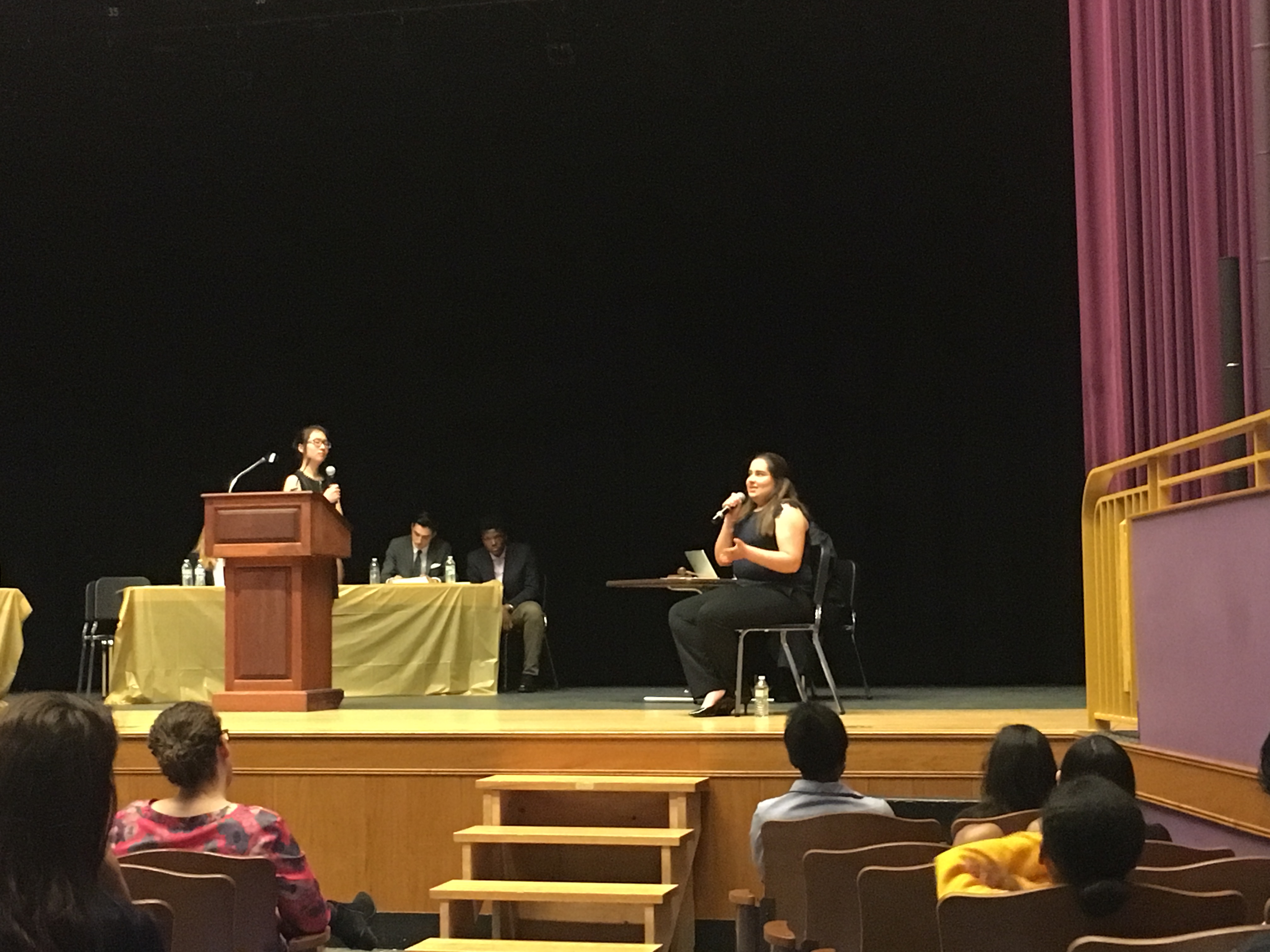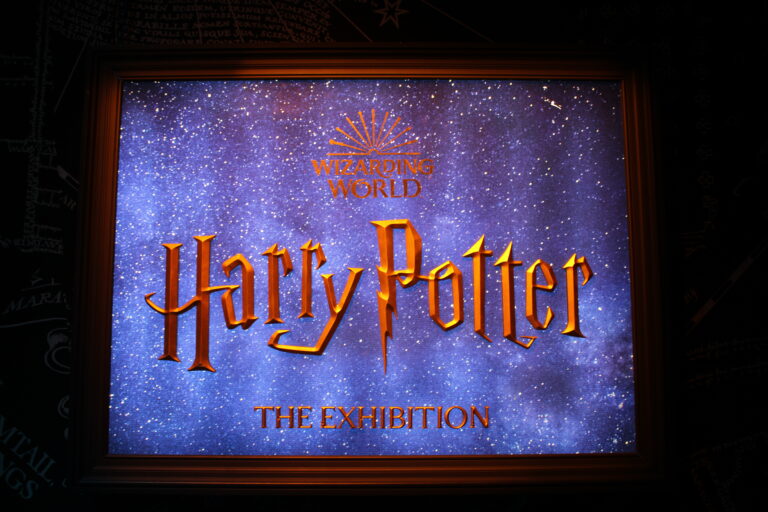
Senior Sanaa Bezzat presents her witness testimony as Gill Graham.
On July 4th, 2016, Sazer Larsen, a war veteran, attended a fireworks display where she shot and killed Jamie Frosh, a high school acquaintance and her long time nemesis. Larsen was tackled by her friend Alex Cofman who had accompanied her to the display, in order to keep her from endangering others or herself and was arrested by officers on site. She was brought into custody, paperwork filed, crime scene examined, and once the evidence had been gathered and the case prepared, her trial ensued on May 2, 2017, beginning at 6pm in the Jenkins Auditorium.
The details of the criminal case, Commonwealth v. Sazer Larsen, have been critically examined by Mock Trial students since November of the beginning of this school year and were presented in a formal trial format. The defense and prosecution were both allowed opening statements, three witnesses or experts, and were expected to use judicial jargon throughout. The trial would assess whether or not post traumatic stress disorder, or PTSD could have influenced the happenings of that night. If Larsen’s PTSD was found to be factor, she would not have to answer to and serve time for First Degree Murder, which warrants premeditated intent to kill.
With the ‘Honorable Judge’ (and MHS history teacher) Richard Tivnan presiding and Mock Trial students assuming the roles of witnesses, examiners, and experts, the trial began.

The prosecution, trying to prove Larsen guilty of the crime, brought up to the bench Detective Daveigh F. Wallace, the investigator on the case, first. Wallace testified that at 9pm on July 4th, she received a call from officers responding to the scene. Once Larsen was brought in, Wallace was the first one to examine her belongings which included the 9 millimeter semiautomatic pistol that Larsen had used that night, a weapon Wallace found to have been cleaned and oiled a few days prior to the crime.
Shortly after, the prosecution introduced Gill Graham, who was the victim’s best friend and had witnessed not only the murder at the fireworks display, but testified that there had always been tensions between the two during high school, beginning with the victim bullying Larsen, and escalated with Larsen’s threats towards the victim.
Lastly, the prosecution called to the stand Doctor Dana Piltch who had first met the defendant in January of 2016 when she administered screenings before discharging the defendant seeing no signs of PTSD.
After cross examinations of the prosecution’s witnesses, the defense team called to the stand their first testimonial, that of Larsen’s friend Cofman, who had been with her on the 4th of July and had tackled her after she’d fired her gun. He testified that Larsen loved America but returned from war differently, withdrawn and aloof. In his retelling of the events, he revealed that Larsen had been jumpy and as soon as the fireworks went off, she turned around screaming “They’re gonna get us!”
Next the defendants brought up Sazer Larsen herself whose retelling of the events was emotional and arguably the most insightful. She talked about the date of the Taliban attack she attributed her nightmares, panic attacks, and PTSD to. She talked about her insomnia and how simply carrying her “favorite firearm” makes her feel safe.
Doctor Carla Li was the last to be called up to the stand, as she was the psychiatric doctor whose diagnosis of Larsen concluded she indeed was experiencing late onset PTSD. She affirmed that “to a reasonable degree of medical certainty,” Larsen’s PTSD was the cause for the crime and even leveled allegations against Doctor Piltch, stating that the method that she had developed and used to misdiagnose Larsen is not a method recognized by the American Psychological Association.
The prosecution’s argument relied heavily on the notion that the murder had been premeditated providing for a rebuttal from the defendant to be mainly based on discrediting the possibility of the killing being pre-planned. The prosecution cited the pistol having been cleaned recently, the sound of the fireworks being sufficient to muffle the sound of the gunshots, and the precision of the shots – two to the head and two to the chest – as evidence that the crime had been premeditated.
The defendant cited the fact that all of Larsen’s weapons in her extensive collection had been cleaned and not just the weapon she may have intended to use as evidence that the killing was not premeditated. They also brought up that the sound of the fireworks themselves were quite possibly what triggered Larsen’s PTSD as the sound is reminiscent of the Taliban attack Larsen had survived through during her tour in Afghanistan.
It is important to acknowledge not only the arguments of both sides and questions posed by direct examiners and cross examiners, but also the performances given by the witnesses and experts, which were also played by Mock Trial members. Senior Sanaa Bezzat, who played Gill Graham, received a positive response from the audience which seemed to partake in her character’s frustration at the repetitive nature of the questions being asked. Bezzat is thankful that she was able to play this role because it helped her “remember there are different areas of law someone can work in.”
With the trial coming to a close, each side was given a chance to deliver their closing statements. Senior Victoria Macdonald, a co-captain of the Mock Trial team, delivered the statements on behalf of the prosecution affirming “Sazer Larsen neglected herself.” Sophomore Birukti Tsige also delivered an assertive closing statement saying “the prosecution failed to prove [Larsen’s guilt],” and pleading with the jury to sympathize with the defendant and understand that there were “two victims.”

With this, the audience, acting as the jury, was asked to text in their vote: (A) for guilty and (B) for not guilty. The poll and it’s results were powered by polleverywhere.com and delivered directly to Judge Tivnan who read the verdict: NOT GUILTY.
If you didn’t get a chance to file your vote, take every detail into consideration and decide for yourself: Is Sazer Larsen guilty of first degree murder? And if the jury doesn’t feel like the side of this case you would’ve preferred to be on, Tsige offers another option saying “if you want to experience scenes that are only available to most people on courtroom dramas, this class is awesome for you.”






